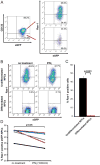Activating receptor NKG2D targets RAE-1-expressing allogeneic neural precursor cells in a viral model of multiple sclerosis
- PMID: 24898518
- PMCID: PMC4165828
- DOI: 10.1002/stem.1760
Activating receptor NKG2D targets RAE-1-expressing allogeneic neural precursor cells in a viral model of multiple sclerosis
Abstract
Transplantation of major histocompatibility complex-mismatched mouse neural precursor cells (NPCs) into mice persistently infected with the neurotropic JHM strain of mouse hepatitis virus (JHMV) results in rapid rejection that is mediated, in part, by T cells. However, the contribution of the innate immune response to allograft rejection in a model of viral-induced neurological disease has not been well defined. Herein, we demonstrate that the natural killer (NK) cell-expressing-activating receptor NKG2D participates in transplanted allogeneic NPC rejection in mice persistently infected with JHMV. Cultured NPCs derived from C57BL/6 (H-2(b) ) mice express the NKG2D ligand retinoic acid early precursor transcript (RAE)-1 but expression was dramatically reduced upon differentiation into either glia or neurons. RAE-1(+) NPCs were susceptible to NK cell-mediated killing whereas RAE-1(-) cells were resistant to lysis. Transplantation of C57BL/6-derived NPCs into JHMV-infected BALB/c (H-2(d) ) mice resulted in infiltration of NKG2D(+) CD49b(+) NK cells and treatment with blocking antibody specific for NKG2D increased survival of allogeneic NPCs. Furthermore, transplantation of differentiated RAE-1(-) allogeneic NPCs into JHMV-infected BALB/c mice resulted in enhanced survival, highlighting a role for the NKG2D/RAE-1 signaling axis in allograft rejection. We also demonstrate that transplantation of allogeneic NPCs into JHMV-infected mice resulted in infection of the transplanted cells suggesting that these cells may be targets for infection. Viral infection of cultured cells increased RAE-1 expression, resulting in enhanced NK cell-mediated killing through NKG2D recognition. Collectively, these results show that in a viral-induced demyelination model, NK cells contribute to rejection of allogeneic NPCs through an NKG2D signaling pathway.
Keywords: Autoimmune disease; NK cells; Nervous system; Neural differentiation; Neural stem cells; Stem cell transplantation; antigenicity.
© 2014 AlphaMed Press.
Conflict of interest statement
Potential Conflict of Interest: L.L.L. and University of California (San Francisco, CA) has licensed intellectual property rights relating to NKG2D for potential therapeutic development.
Figures







Similar articles
-
MHC mismatch results in neural progenitor cell rejection following spinal cord transplantation in a model of viral-induced demyelination.Stem Cells. 2012 Nov;30(11):2584-95. doi: 10.1002/stem.1234. Stem Cells. 2012. PMID: 22969049 Free PMC article.
-
Natural killer cells recognize friend retrovirus-infected erythroid progenitor cells through NKG2D-RAE-1 interactions In Vivo.J Virol. 2011 Jun;85(11):5423-35. doi: 10.1128/JVI.02146-10. Epub 2011 Mar 16. J Virol. 2011. PMID: 21411527 Free PMC article.
-
Natural killer cell-activating receptor NKG2D mediates innate immune targeting of allogeneic neural progenitor cell grafts.Stem Cells. 2013 Sep;31(9):1829-39. doi: 10.1002/stem.1422. Stem Cells. 2013. PMID: 23733329 Free PMC article.
-
Regulation of ligands for the NKG2D activating receptor.Annu Rev Immunol. 2013;31:413-41. doi: 10.1146/annurev-immunol-032712-095951. Epub 2013 Jan 3. Annu Rev Immunol. 2013. PMID: 23298206 Free PMC article. Review.
-
Potential role of NKG2D and its ligands in organ transplantation: new target for immunointervention.Am J Transplant. 2009 Feb;9(2):251-7. doi: 10.1111/j.1600-6143.2008.02526.x. Am J Transplant. 2009. PMID: 19178412 Review.
Cited by
-
Promoting remyelination through cell transplantation therapies in a model of viral-induced neurodegenerative disease.Dev Dyn. 2019 Jan;248(1):43-52. doi: 10.1002/dvdy.24658. Epub 2018 Sep 6. Dev Dyn. 2019. PMID: 30067309 Free PMC article. Review.
-
LncRNA MBNL1-AS1 Represses Proliferation and Cancer Stem-Like Properties of Breast Cancer through MBNL1-AS1/ZFP36/CENPA Axis.J Oncol. 2022 Apr 26;2022:9999343. doi: 10.1155/2022/9999343. eCollection 2022. J Oncol. 2022. PMID: 35518784 Free PMC article.
-
Stem Cells as Potential Targets of Polyphenols in Multiple Sclerosis and Alzheimer's Disease.Biomed Res Int. 2018 Jul 12;2018:1483791. doi: 10.1155/2018/1483791. eCollection 2018. Biomed Res Int. 2018. PMID: 30112360 Free PMC article. Review.
-
The current state of knowledge on the role of NKG2D ligands in multiple sclerosis and other autoimmune diseases.Front Mol Neurosci. 2025 Jan 10;17:1493308. doi: 10.3389/fnmol.2024.1493308. eCollection 2024. Front Mol Neurosci. 2025. PMID: 39866909 Free PMC article. Review.
-
Promoting remyelination: utilizing a viral model of demyelination to assess cell-based therapies.Expert Rev Neurother. 2014 Oct;14(10):1169-79. doi: 10.1586/14737175.2014.955854. Expert Rev Neurother. 2014. PMID: 25245576 Free PMC article. Review.
References
-
- Markovic-Plese S, Pinilla C, Martin R. The initiation of the autoimmune response in multiple sclerosis. Clin Neurol Neurosurg. 2004;106:218–222. - PubMed
-
- De Stefano N, Matthews PM, Fu L, et al. Axonal damage correlates with disability in patients with relapsing-remitting multiple sclerosis. Results of a longitudinal magnetic resonance spectroscopy study. Brain. 1998;121(Pt 8):1469–1477. - PubMed
-
- Bruck W. The pathology of multiple sclerosis is the result of focal inflammatory demyelination with axonal damage. J Neurol. 2005;252(Suppl 5):v3–9. - PubMed
Publication types
MeSH terms
Substances
Grants and funding
LinkOut - more resources
Full Text Sources
Other Literature Sources
Medical

